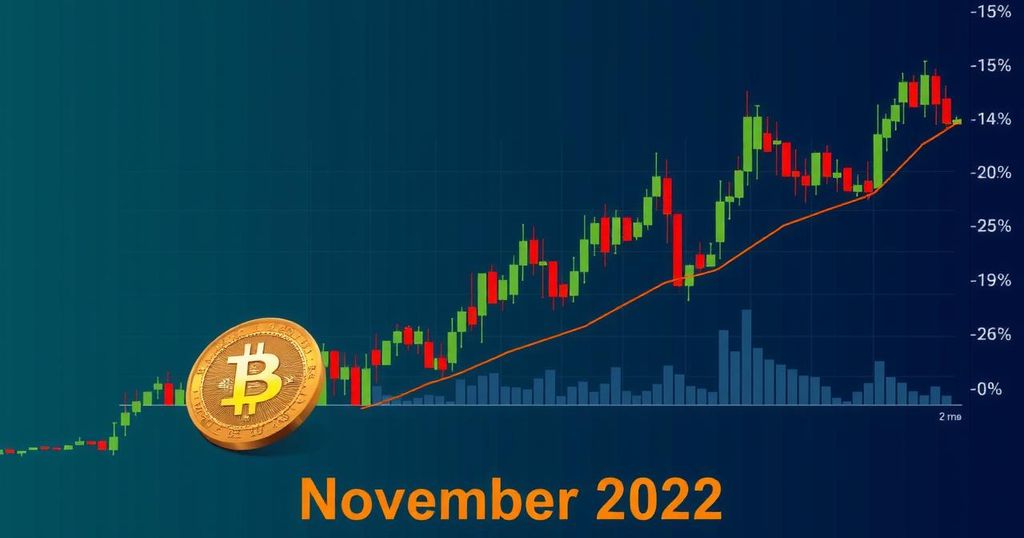Should Individual Investors Follow MicroStrategy’s All-In Bitcoin Strategy?
Summary
MicroStrategy has engaged in a significant Bitcoin purchasing strategy that has escalated its stock value by over 100%. Michael Saylor predicts Bitcoin’s value could reach $13 million by 2045, necessitating a 30% annual growth rate. Despite past successes, the strategy lacks diversification and comes with inherent volatility risks, suggesting caution for individual investors considering similar moves.
MicroStrategy, under the leadership of Michael Saylor, has been aggressively purchasing Bitcoin since August 2020, culminating in an astonishing $1.1 billion purchase announced on September 13, 2023. This brings the company’s total Bitcoin investments to approximately $14.6 billion, equating to more than 1% of the global Bitcoin supply, surpassing even the holdings of the U.S. government. This bold strategy has proven fruitful, with MicroStrategy’s stock value soaring by over 100% this year while Bitcoin has experienced a 40% increase and the S&P 500 has only risen by about 20%. Saylor estimates the future value of a single Bitcoin to reach an astronomical $13 million by 2045, necessitating a consistent annual growth rate of 30%. Although Bitcoin has delivered remarkable annual returns of 230% from 2011 to 2021 and is up in recent years, achieving sustained 30% returns over a 21-year period poses significant risks. Historical data shows that Bitcoin prices have plummeted dramatically during market corrections, with five distinct instances of 77% declines or more, including a 65% drop in 2022. MicroStrategy’s approach has transformed it into a proxy for Bitcoin investments, with its Bitcoin holdings constituting over half of the company’s market value. The endeavor is notably financed through convertible debt, akin to individuals utilizing credit for Bitcoin purchases, risking considerable financial liability. The overarching question is whether individual investors should adopt such an all-in strategy on Bitcoin. While MicroStrategy’s results may seem exemplary, the lack of diversification in their portfolio strategy raises concerns. Conventional investment wisdom suggests Bitcoin should constitute a mere 1%-3% of a portfolio, whereas MicroStrategy’s allocation is far more concentrated. Thus, while the potential for substantial gains exists, the prudent route for individual investors would be to ensure adequate risk management and diversification in their investment approach. This strategy allows them to capitalize on Bitcoin’s promising prospects without overly exposing themselves to its inherent volatility.
MicroStrategy has emerged as a notable player in the cryptocurrency investment space, largely due to its aggressive Bitcoin buying strategy. Founded in 1989, the company originally focused on business intelligence software, but under the direction of CEO Michael Saylor, it has shifted its focus predominantly towards Bitcoin investments. Starting in August 2020, the firm has made substantial purchases of Bitcoin, leading to a significant appreciation in its stock value and establishing it as a primary corporate entity associated with cryptocurrency investments. This article evaluates the potential risks and returns of such a concentrated investment strategy, particularly in the context of Bitcoin’s historical price volatility and market dynamics.
In conclusion, while MicroStrategy’s extensive Bitcoin investments have yielded impressive returns and established the firm as a leader in cryptocurrency holdings, the underlying strategy poses significant risks, particularly the lack of diversification. Individual investors should approach the prospect of investing heavily in Bitcoin with caution. The potential for extraordinary gains is countered by the volatility and historical drawdowns of Bitcoin, necessitating a balanced investment approach that includes diversification to mitigate risks effectively. A prudent investment strategy would involve allocating a minimal proportion of one’s portfolio to Bitcoin while exploring a broader array of assets to secure financial stability.
Original Source: www.fool.com








Post Comment